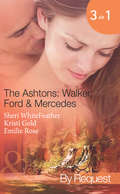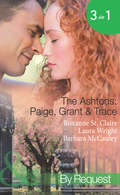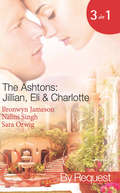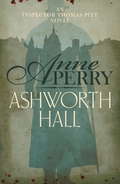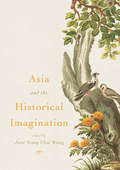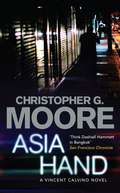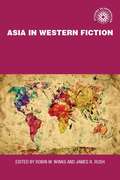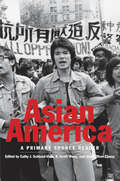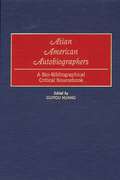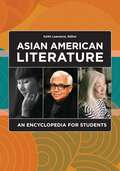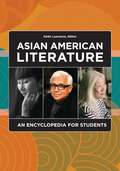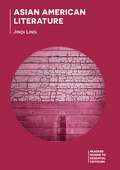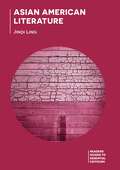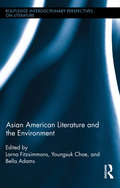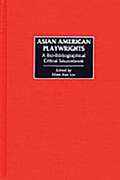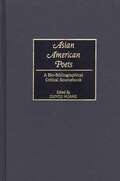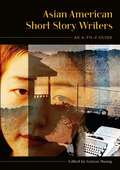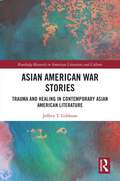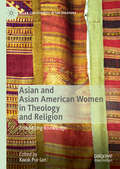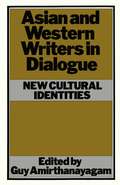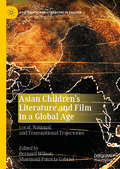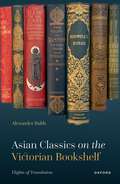- Table View
- List View
The Ashtons: Walker, Ford And Mercedes
by Kristi Gold Emilie Rose Sheri WhiteFeatherFamily, lies, secrets and passion Betrayed Birthright Sheri White
The Ashtons: Paige, Grant And Trace (Mills And Boon Spotlight Ser.)
by Laura Wright Barbara McCauley Roxanne St. ClaireBack by popular demand! These great value titles feature stories from Mills & Boon fans' favourite authors. The Ashton Dynasty – Scandalous, passionate and built on lies! Nothing is as it seems.
The Ashtons: Jillian, Eli & Charlotte
by Sara Orwig Bronwyn Jameson Nalini SinghThe Ashtons – a family with dark passionate secrets…
Ashworth Hall: Politics and murder entwine in Victorian London (Thomas Pitt Mystery #17)
by Anne PerryCan Pitt solve the case before the killer strikes again? The murder of a prominent politician has links to Irish civil unrest in Anne Perry's gripping Victorian mystery, Ashworth Hall. Perfect for fans of C. J. Sansom and Sarah Perry.'Elegant period novel with a contemporary resonance' - Guardian When a group of powerful Irish Protestants and Catholics gather at a country house to discuss Irish home rule, contention is to be expected. But when the meeting's moderator, government bigwig Ainsley Greville, is found murdered in his bath, negotiations seem doomed. Unless Superintendent Thomas Pitt and his wife, Charlotte, can root out the truth, simmering hatreds and passions may again explode in murder. What readers are saying about Anne Perry: 'The atmosphere of turn of the century London is so absorbing and tangible that you can almost feel yourself shrouded in a cold blanket of East End fog and hear the Hansom carriages clatter along the streets''These are a great set of books. Pitt is a really likeable hero''Five stars'
Asia and the Historical Imagination
by Jane Yeang WongThis collection explores the interpretation of historical fiction through fictional representations of the past in an Asian context. Emphasising the significance of region and locality, it explores local networks of political and cultural exchanges at the heart of an Asian polity. The book considers how imagined pasts converge and diverge in developed and developing nations, and examines the limitations of representation at a time when theories of world literature are shaping the way we interpret global histories and cultures. The collection calls attention to the importance of acknowledging local tensions—both within the historical and cultural make-up of a country, and within the Asian continent—in the interpretation of historical fiction. It emphasizes a broad-spectrum view that privileges the shared historical experiences of a group of countries in close proximity, and it also responds to the paradigm shift in Asian Studies. Discussing how local conditions shape and create expectations of how we read historical fiction and working with the theme of fictionality and locality, the volume provides an alternative framework for the study of world literature.
Asia and the Historical Imagination
by Jane Yeang WongThis collection explores the interpretation of historical fiction through fictional representations of the past in an Asian context. Emphasising the significance of region and locality, it explores local networks of political and cultural exchanges at the heart of an Asian polity. The book considers how imagined pasts converge and diverge in developed and developing nations, and examines the limitations of representation at a time when theories of world literature are shaping the way we interpret global histories and cultures. The collection calls attention to the importance of acknowledging local tensions—both within the historical and cultural make-up of a country, and within the Asian continent—in the interpretation of historical fiction. It emphasizes a broad-spectrum view that privileges the shared historical experiences of a group of countries in close proximity, and it also responds to the paradigm shift in Asian Studies. Discussing how local conditions shape and create expectations of how we read historical fiction and working with the theme of fictionality and locality, the volume provides an alternative framework for the study of world literature.
Asia Hand (Vincent Calvino #4)
by Christopher G MooreBangkok - the Year of the Monkey. Vincent Calvino is spending the New Year on a call-out to Lumpini Park Lake, where the Thai cops have fished out the body of a farang cameraman. Calvino traces the American's murder to an elite unit of old Asia hands - a set of foreigners with bad reputations and powerful friends.
Asia in Western fiction (Studies in Imperialism)
by Robin WinksAny reader who has ever visited Asia knows that the great bulk of Western-language fiction about Asian cultures turns on stereotypes. This book, a collection of essays, explores the problem of entering Asian societies through Western fiction, since this is the major port of entry for most school children, university students and most adults. In the thirteenth century, serious attempts were made to understand Asian literature for its own sake. Hau Kioou Choaan, a typical Chinese novel, was quite different from the wild and magical pseudo-Oriental tales. European perceptions of the Muslim world are centuries old, originating in medieval Christendom's encounter with Islam in the age of the Crusades. There is explicit and sustained criticism of medieval mores and values in Scott's novels set in the Middle Ages, and this is to be true of much English-language historical fiction of the nineteenth and early twentieth centuries. Even mediocre novels take on momentary importance because of the pervasive power of India. The awesome, remote and inaccessible Himalayas inevitably became for Western writers an idealised setting for novels of magic, romance and high adventure, and for travellers' tales that read like fiction. Chinese fictions flourish in many guises. Most contemporary Hong Kong fiction reinforced corrupt mandarins, barbaric punishments and heathens. Of the novels about Japan published after 1945, two may serve to frame a discussion of Japanese behaviour as it could be observed (or imagined) by prisoners of war: Black Fountains and Three Bamboos.
Asian America: A Primary Source Reader (Critical Perspectives On Asian Pacific Americans Ser. #10)
by Cathy J. Schlund-Vials K. Scott Wong Jason Oliver ChangAn essential collection that brings together the core primary texts of the Asian American experience in one volume An essential volume for the growing academic discipline of Asian American studies, this collection of core primary texts draws from a wide range of fields, from law to visual culture to politics, covering key historical and cultural developments that enable students to engage directly with the Asian American experience over the past century. The primary sources, organized around keywords, often concern multiple hemispheres and movements, making this compendium valuable for a number of historical, ethnic, and cultural study undergraduate programs.
Asian American Autobiographers: A Bio-Bibliographical Critical Sourcebook (Non-ser.)
by Guiyou HuangAsian Americans have made many significant contributions to industry, science, politics, and the arts. At the same time, they have made great sacrifices and endured enormous hardships. This reference examines autobiographies and memoirs written by Asian Americans in the twentieth century. Included are alphabetically arranged entries on 60 major autobiographers of Asian descent. Some of these, such as Meena Alexander and Maxine Hong Kingston, are known primarily for their writings; others, such as Daniel K. Inouye, are known largely for other achievements, which they have chronicled in their autobiographies.Each entry is written by an expert contributor and provides a reliable account of the autobiographer's life; reviews major autobiographical works and themes, including fictionalized autobiographies and autobiographical novels; presents a meticulously researched account of the critical reception of these works; and closes with a bibliography of primary and secondary sources. An introductory essay considers the history and development of autobiography in American literature and culture and discusses issues and themes vital to Asian American autobiographies and memoirs, such as family, diaspora, nationhood, identity, cultural assimilation, racial dynamics, and the formation of the Asian American literary canon. The volume closes with a selected bibliography.
Asian American Literature: An Encyclopedia for Students
by Keith LawrenceAsian American Literature: An Encyclopedia for Students is an invaluable resource for students curious to know more about Asian North American writers, texts, and the issues and drives that motivate their writing.This volume collects, in one place, a breadth of information about Asian American literary and cultural history as well as the authors and texts that best define it.A dozen contextual essays introduce fundamental elements or subcategories of Asian American literature, expanding on social and literary concerns or tensions that are familiar and relevant. Essays include the origins and development of the term "Asian American"; overviews of Asian American and Asian Canadian social and literary histories; essays on Asian American identity, gender issues, and sexuality; and discussions of Asian American rhetoric and children's literature. More than 120 alphabetical entries round out the volume and cover important Asian North American authors. Historical information is presented in clear and engaging ways, and author entries emphasize biographical or textual details that are significant to contemporary young adults. Special attention has been given to pioneering authors from the late 19th century through the early 1970s and to influential or well-known contemporary authors, especially those likely to be studied in high school or university classrooms.
Asian American Literature: An Encyclopedia for Students
by Keith LawrenceAsian American Literature: An Encyclopedia for Students is an invaluable resource for students curious to know more about Asian North American writers, texts, and the issues and drives that motivate their writing.This volume collects, in one place, a breadth of information about Asian American literary and cultural history as well as the authors and texts that best define it.A dozen contextual essays introduce fundamental elements or subcategories of Asian American literature, expanding on social and literary concerns or tensions that are familiar and relevant. Essays include the origins and development of the term "Asian American"; overviews of Asian American and Asian Canadian social and literary histories; essays on Asian American identity, gender issues, and sexuality; and discussions of Asian American rhetoric and children's literature. More than 120 alphabetical entries round out the volume and cover important Asian North American authors. Historical information is presented in clear and engaging ways, and author entries emphasize biographical or textual details that are significant to contemporary young adults. Special attention has been given to pioneering authors from the late 19th century through the early 1970s and to influential or well-known contemporary authors, especially those likely to be studied in high school or university classrooms.
Asian American Literature (Readers' Guides to Essential Criticism)
by Jinqi LingThis book introduces Asian American literary studies by engaging the conditions, contingencies, and immediate and long-term effects of its major debates. Two rationales inform Ling's presentation of the field in this way: first is a felt need to provide recognizable contours and trajectories for the evolution of Asian American criticism as an ethnic-specific minoritarian formation in the United States; second is an imperative to historicize its practices - including polemics, controversies, and ideological ruptures - as an ongoing negotiation undertaken by Asian American critics for a more self-conscious and more adequate representation of the field's interests. These rationales are fully contextualized in the book's Introduction and Conclusion. The main body of this study is organized non-chronologically into 8 chapters, with each designed to reflect how the field has been energized by its demographic transformation, its growing intellectual heterogeneity, its defining moments, and its cross-cutting relationship with the trends in other disciplines. What has emerged and been given prominence to in the surveys and discussions of this book then constitute the essential criticism of Asian American literary studies, a discourse almost 5 decades in the making when examined retrospectively.
Asian American Literature (Readers' Guides to Essential Criticism)
by Jinqi LingThis book introduces Asian American literary studies by engaging the conditions, contingencies, and immediate and long-term effects of its major debates. Two rationales inform Ling's presentation of the field in this way: first is a felt need to provide recognizable contours and trajectories for the evolution of Asian American criticism as an ethnic-specific minoritarian formation in the United States; second is an imperative to historicize its practices - including polemics, controversies, and ideological ruptures - as an ongoing negotiation undertaken by Asian American critics for a more self-conscious and more adequate representation of the field's interests. These rationales are fully contextualized in the book's Introduction and Conclusion. The main body of this study is organized non-chronologically into 8 chapters, with each designed to reflect how the field has been energized by its demographic transformation, its growing intellectual heterogeneity, its defining moments, and its cross-cutting relationship with the trends in other disciplines. What has emerged and been given prominence to in the surveys and discussions of this book then constitute the essential criticism of Asian American literary studies, a discourse almost 5 decades in the making when examined retrospectively.
Asian American Literature and the Environment (Routledge Interdisciplinary Perspectives on Literature)
by Lorna Fitzsimmons Youngsuk Chae Bella AdamsThis book is a ground-breaking transnational study of representations of the environment in Asian American literature. Extending and renewing Asian American studies and ecocriticism by drawing the two fields into deeper dialogue, it brings Asian American writers to the center of ecocritical studies. This collection demonstrates the distinctiveness of Asian American writers’ positions on topics of major concern today: environmental justice, identity and the land, war environments, consumption, urban environments, and the environment and creativity. Represented authors include Amy Tan, Maxine Hong Kingston, Ruth Ozeki, Ha Jin, Fae Myenne Ng, Le Ly Hayslip, Lan Cao, Mitsuye Yamada, Lawson Fusao Inada, Jeanne Wakatsuki Houston, Milton Murayama, Don Lee, and Hisaye Yamamoto. These writers provide a range of perspectives on the historical, social, psychological, economic, philosophical, and aesthetic responses of Asian Americans to the environment conceived in relation to labor, racism, immigration, domesticity, global capitalism, relocation, pollution, violence, and religion. Contributors apply a diversity of critical frameworks, including critical radical race studies, counter-memory studies, ecofeminism, and geomantic criticism. The book presents a compelling and timely "green" perspective through which to understand key works of Asian American literature and leads the field of ecocriticism into neglected terrain.
Asian American Literature and the Environment (Routledge Interdisciplinary Perspectives on Literature)
by Lorna Fitzsimmons Youngsuk Chae Bella AdamsThis book is a ground-breaking transnational study of representations of the environment in Asian American literature. Extending and renewing Asian American studies and ecocriticism by drawing the two fields into deeper dialogue, it brings Asian American writers to the center of ecocritical studies. This collection demonstrates the distinctiveness of Asian American writers’ positions on topics of major concern today: environmental justice, identity and the land, war environments, consumption, urban environments, and the environment and creativity. Represented authors include Amy Tan, Maxine Hong Kingston, Ruth Ozeki, Ha Jin, Fae Myenne Ng, Le Ly Hayslip, Lan Cao, Mitsuye Yamada, Lawson Fusao Inada, Jeanne Wakatsuki Houston, Milton Murayama, Don Lee, and Hisaye Yamamoto. These writers provide a range of perspectives on the historical, social, psychological, economic, philosophical, and aesthetic responses of Asian Americans to the environment conceived in relation to labor, racism, immigration, domesticity, global capitalism, relocation, pollution, violence, and religion. Contributors apply a diversity of critical frameworks, including critical radical race studies, counter-memory studies, ecofeminism, and geomantic criticism. The book presents a compelling and timely "green" perspective through which to understand key works of Asian American literature and leads the field of ecocriticism into neglected terrain.
Asian American Playwrights: A Bio-Bibliographical Critical Sourcebook
by Miles LiuIn the late nineteenth century, Asian American drama made its debut with the spotlight firmly on the lives and struggles of Asians in North America, rather than on the cultures and traditions of the Asian homeland. Today, Asian American playwrights continue to challenge the limitations of established theatrical conventions and direct popular attention toward issues and experiences that might otherwise be ignored or marginalized. While Asian American literature came into full bloom in the last 25 years, Asian American drama has yet to receive the kind of critical attention it warrants. This reference book serves as a versatile vehicle for exploring the field of Asian American drama from its recorded conception to its present stage.Included are alphabetically arranged entries for 52 Asian American dramatists of origins from India, Pakistan, Vietnam, the Philippines, Japan, Korea, and China. Each entry includes relevant biographical information that contextualizes the works of a playwright, an interpretive description of selected plays that spotlights recurring themes and plots, a summary of the playwright's critical reception, and a bibliography of primary and secondary works. The entries are written by expert contributors and reflect the ethnic diversity of the Asian American community. The volume closes with a selected, general bibliography, which includes anthologies, scholarly studies, and periodicals.
Asian American Poets: A Bio-Bibliographical Critical Sourcebook (Non-ser.)
by Guiyou HuangEven though Asian American literature is enjoying an impressive critical popularity, attention has focused primarily on longer narrative forms such as the novel. And despite the proliferation of a large number of poets of Asian descent in the 20th century, Asian American poetry remains a neglected area of study. Poetry as an elite genre has not reached the level of popularity of the novel or short story, partly due to the difficulties of reading and interpreting poetic texts. The lack of criticism on Asian American poetry speaks to the urgent need for scholarship in this area, since perhaps more than any other genre, poetry most forcefully captures the intense feelings and emotions that Asian Americans have experienced about themselves and their world. This reference book overviews the tremendous cultural contributions of Asian American poets.Included are alphabetically arranged entries on 48 American poets of Asian descent, most of whom have been active during the latter half of the 20th century. Each entry begins with a short biography, which sometimes includes information drawn from personal interviews. The entries then discuss the poet's major works and themes, including such concerns as family, racism, sexism, identity, language, and politics. A survey of the poet's critical reception follows. In many cases the existing criticism is scant, and the entries offer new readings of neglected works. The entries conclude with bibliographies of primary and secondary texts, and the volume closes with a selected, general bibliography.
Asian American Short Story Writers: An A-to-Z Guide
by Guiyou HuangAsian America has produced numerous short-story writers in the 20th century. Some emerged after World War II, yet most of these writers have flourished since 1980. The first reference of its kind, this volume includes alphabetically arranged entries for 49 nationally and internationally acclaimed Asian American writers of short fiction. Each entry is written by an expert contributor and includes a biography, a discussion of major works and themes, a survey of the writer's critical reception, and primary and secondary bibliographies.Writers include Frank Chin, Sui Sin Far, Shirely Geok-lin Lim, Toshio Mori, and Bharati Mukherjee. An introductory essay provides a close examination of the Asian American short story, and the volume closes with a list of works for further reading.
Asian American War Stories: Trauma and Healing in Contemporary Asian American Literature (Routledge Research in American Literature and Culture)
by Jeffrey Tyler GibbonsAsian American War Stories examines contemporary Asian American literature that considers both the short-term and the long-term effects of war, trauma, and displacement on civilians, as well as the ways that individuals seek healing in the face of suffering. Through the works of contemporary writers like Chang-rae Lee, Ocean Vuong, Nora Okja Keller, Julie Otsuka, Lan Cao, and Lawson Inada, this book explores the ways that recent Asian American literature reflects the enduring consequences of America’s wars in Asia at the individual and collective levels. The book also considers the journeys that individuals take as they pursue healing of their traumatic wounds.
Asian American War Stories: Trauma and Healing in Contemporary Asian American Literature (Routledge Research in American Literature and Culture)
by Jeffrey Tyler GibbonsAsian American War Stories examines contemporary Asian American literature that considers both the short-term and the long-term effects of war, trauma, and displacement on civilians, as well as the ways that individuals seek healing in the face of suffering. Through the works of contemporary writers like Chang-rae Lee, Ocean Vuong, Nora Okja Keller, Julie Otsuka, Lan Cao, and Lawson Inada, this book explores the ways that recent Asian American literature reflects the enduring consequences of America’s wars in Asia at the individual and collective levels. The book also considers the journeys that individuals take as they pursue healing of their traumatic wounds.
Asian and Asian American Women in Theology and Religion: Embodying Knowledge (Asian Christianity in the Diaspora)
by Pui-Lan KwokThis book presents personal narratives and collective ethnography of the emergence and development of Asian and Asian American women’s scholarship in theology and religious studies. It demonstrates how the authors’ religious scholarship is based on an embodied epistemology influenced by their social locations. Contributors reflect on their understanding of their identity and how this changed over time, the contribution of Asian and Asian American women to the scholarship work that they do, and their hopes for the future of their fields of study. The volume is multireligious and intergenerational, and is divided into four parts: identities and intellectual journeys, expanding knowledge, integrating knowledge and practice, and dialogue across generations.
Asian Children’s Literature and Film in a Global Age: Local, National, and Transnational Trajectories (Asia-Pacific and Literature in English)
by Bernard Wilson Sharmani Patricia GabrielThis volume provides a key analysis of Asian children’s literature and film and creates a dialogue between East and West and between the cultures from which they emerge, within the complex symbiosis of their local, national and transnational frameworks. In terms of location and content the book embraces a broad scope, including contributions related to the Asian-American diaspora, China, India, Indonesia, Iran, Japan, Malaysia, the Philippines, South Korea, Sri Lanka, and Taiwan. Individually and collectively, these essays broach crucial questions: What elements of Asian literature and film make them distinctive, both within their own specific culture and within the broader Asian area? What aspects link them to these genres in other parts of the world? How have they represented and shaped the societies and cultures they inhabit? What moral codes do they address, underpin, or contest? The volume provides further voice to the increasingly diverse and fascinating output of the region and emphasises the importance of Asian art forms as depictions of specific cultures but also of their connection to broader themes in children’s texts, and scholarship within this field.
Asian Classics on the Victorian Bookshelf: Flights of Translation
by Alexander BubbThe interest among Victorian readers in classical literature from Asia has been greatly underestimated. The popularity of the Arabian Nights and The Rubaiyat of Omar Khayyam is well documented. Yet this was also an era in which freethinkers consulted the Quran, in which schoolchildren were given abridgements of the Ramayana to read, in which names like 'Kalidasa' and 'Firdusi' were carved on the façades of public libraries, and in which women's book clubs discussed Japanese poetry. But for the most part, such readers were not consulting the specialist publications of scholarly orientalists. What then were the translations that catalysed these intercultural encounters? Based on a unique methodology marrying translation theory with empirical techniques developed by historians of reading, this book shines light for the first time on the numerous amateur translators or 'popularizers', who were responsible for making these texts accessible and disseminating them to the Victorian general readership. Asian Classics on the Victorian Bookshelf explains the process whereby popular translations were written, published, distributed to bookshops and libraries, and ultimately consumed by readers. It uses the working papers and correspondence of popularizers to demonstrate their techniques and motivations, while the responses of contemporary readers are traced through the pencil marginalia they left behind in dozens of original copies. In spite of their typically limited knowledge of source-languages, Asian Classics argues that popularizers produced versions more respectful of the complexity, cultural difference, and fundamental untranslatability of Asian texts than the professional orientalists whose work they were often adapting. The responses of their readers, likewise, frequently deviated from interpretive norms, and it is proposed that this combination of eccentric translators and unorthodox readers triggered 'flights of translation', whereby historical individuals can be seen to escape the hegemony of orientalist forms of knowledge.
